

(Fig.S) Electron spin is an unreal faster-than-light spinning.
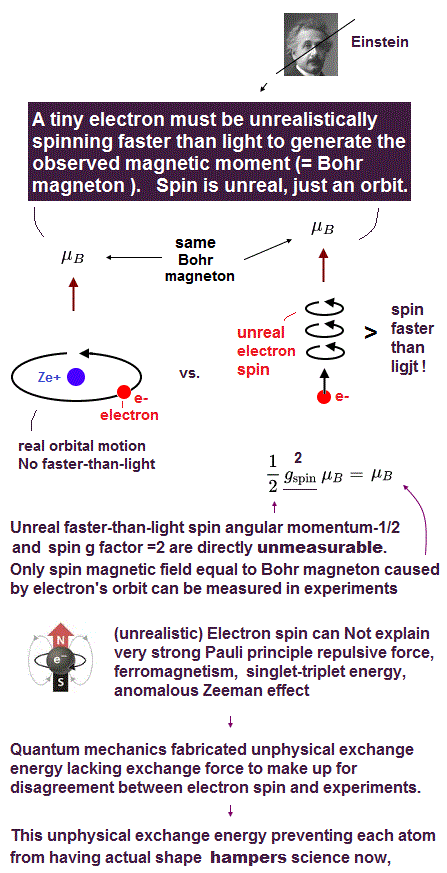
Electron spin is unrealistic because a tiny (point-like) electron must be spinning much faster-than-light to generate the observed magnetic moment ( this lower, this or this ).
So quantum mechanics paradoxically started to claim this unphysical electron spin is Not actual spinning, though it allegedly has spin angular momentum.
This 3rd-paragraph says -- Unreal superluminal spin
"physicists soon determined that an electron would have to be spinning much faster than the speed of light to produce the effects they were seeing" ← Electron spinning is unreal.
This paradoxical nature of electron spin makes us realize we can explain all the experimental results based on this fictional electron spin by realistic electron's orbital motion.
Because both electron's orbital motion and fictitious spin are said to have the same indistinguishable magnetic field called Bohr magneton (= μB = only this magnetic field is measurable ) of Bohr's realistic orbit. ← Electron spin is unnecessary ( this p.2 ) with No experimental proof.
↑ Unphysical spin's angular momentum-1/2 or g-factor-2 can Not be directly measured (= spin-g-factor=2 has to be guessed from the measured Bohr magneton divided by unmeasurable spin-1/2 angular momentum allegedly caused by Not-real rotation, this p.4-2-obstacle ).
The unphysical quantum electrodynamics (= QED ) based on fictional virtual particles always gives meaningless infinities (+ artificial cancellation or hocus-pocus renormalization by other infinities ), which can Not predict spin-g-factor or anomalous magnetic moment at all, contrary to hypes.
↑ No evidence of electron spin-1/2.
In addition to the unphysical faster-than-light electron spinning ( this p.2-1.1 ), the electron spin unrealistically can Not be slowed down or accelerated no matter how many times electrons collide or interact with other particles ( this-1st-paragraph, this 3rd-paragraph, this 13th-paragraph ). ← Quantum mechanics provides No reason why the electron spinning speed is Not slowed down or changed.
On the other hand, the realistic electron's orbital motion can naturally explain the constant angular momentum or Bohr magneton based on the experimentally-verified de Broglie wave theory keeping the same angular momentum = an integer × ℏ ( this p.6 ) to avoid destructive interference of de Broglie wave.
As I said, the electron spin lacks reality, and its (measurable) magnetic moment can be replaced by the realistic electron's orbit, so the electron spin is unnecessary.
Atomic fine structure allegedly caused by the paradoxical spin-orbit magnetic energy can be naturally explained by the realistic Bohr-Sommerfeld fine structure without spin ( this 5th-paragraph, this-lower historical footnote ).
Anomalous Zeeman effect seen in alkali atoms such as sodium is too big to explain by the tiny spin-orbit magnetic interaction, so the electron spin disagrees with experimental results.
The energy difference between singlet (= spin up an down ? ) and triplet (= spin up-up, down-down ? ) states is as large as Coulomb electric energy (= 1 ~ 2 eV, this p.3-middle, this 3s3p singlet 1p and triplet 3p energy difference is 13140cm-1 = 1.629 eV ), which is far bigger than the tiny spin-orbit or spin-spin magnetic energy (= 0.0001 eV, this-p.10-left-2nd-paragraph, this-p.17, this-p.3-4 ). ← electron spin cannot explain singlet-triplet large energy difference.
Pauli exclusion repulsive energy and ferromagnetism are also too strong to explain with the tiny spin-spin magnetic interaction (= electron spin magnetic energy is too weak, and useless ).
So quantum mechanics had to introduce the unphysical concept called exchange energy ( this p.17-19, this p.11-12 ) lacking exchange force ( this p.9-upper ) to explain these Pauli principle, ferromagnetism, singlet-triplet energy levels, whose energies are far bigger than the original spin-spin magnetic energy.
This unphysical exchange energy needs antisymmetric wavefunctions where all electrons in different orbitals and different atoms must be magically exchanged (= so each electron must unrealistically exist in all different atoms in this antisymmetric exchange wavefunction ).
All quantum mechanical Schrödinger equations for multi-electron atoms are unsolvable, so physicists have to artificially choose fake trial wavefunctions or basis sets with freely adjustable parameters as (fake) atomic unsolvable solutions, which cannot predict any physical values, and quantum mechanics is useless.
This Schrödinger equation is not only unsolvable, unable to predict any physical values, but also too time-consuming to calculate the energies of the chosen (fake) antisymmetric wavefunctions that must exchange all electrons' orbitals ( this p.2-3, p.5 ), and calculate all combinations of exchange energies.
The unphysical Pauli antisymmetric wavefunction makes quantum mechanics rely on the ad-hoc rough approximation treating all different electrons as one-pseudo-electron or fictional quasiparticle model with fake (effective) mass in the current mainstream density functional theory (= DFT or Kohn-Sham theory, this p.3-5 ).
This one-pseudo-electron DFT must artificially choose (fake) exchange-correlation energy functional (= including the unphysical exchange energy ) and pseudo-potential, which cannot predict any values, so the unphysical exchange energy (= related to electron spin ) is an artificial concept irrelevant to quantum mechanical prediction (= DFT is Not ab-initio but just empirical, this 7~9th-paragraphs, this p.23 ).
↑ So the electron spin is also artificial, Not the result of quantum mechanical prediction (= No evidence of electron spin ).
In these antisymmetric wavefunctions and one-pseudo-electron DFT approximation, each electron must unrealistically exist in all different atoms and orbitals (= single electron is unrealistically shared by all atoms ) by the unphysical exchange interaction, which prevents each atom from having definite shape and boundary.
As a result, quantum mechanical unphysical exchange energy lacking exchange force hampers scientific development by preventing researchers from using real atomic models with experimentally-measurable shapes and boundaries.
This unphysical quantum mechanical exchange energy lacking exchange force is said to be caused by (fictitious) kinetic energy change ( this p.9-10 ) due to de Broglie wave (= Schrodinger wavefunction is also based on de Broglie wave theory ) interference in antisymmetric wavefunction.
↑ We should stop using these unrealistic quantum mechanical exchange energy (= linked to unrealistic electron spin ), quasiparticle, one-pseudo-electron DFT to develop useful nanotechnology based on real atomic model with actual shapes and real Pauli repulsive force based on real de Broglie wave.
↑ This unreal quantum mechanical Pauli principle based on pseudo-kinetic energy increase instead of real Pauli repulsive potential (= by de Broglie wave ) is why quantum mechanics is useless, cannot solve Schrödinger equation (= Not conserve energy ) nor predict any molecular energy.
(Fig.E) Energy splitting in ESR can be explained by classical electron's orbit whose magnetic moment μB = Bohr magneton is the same as the unreal electron spin.
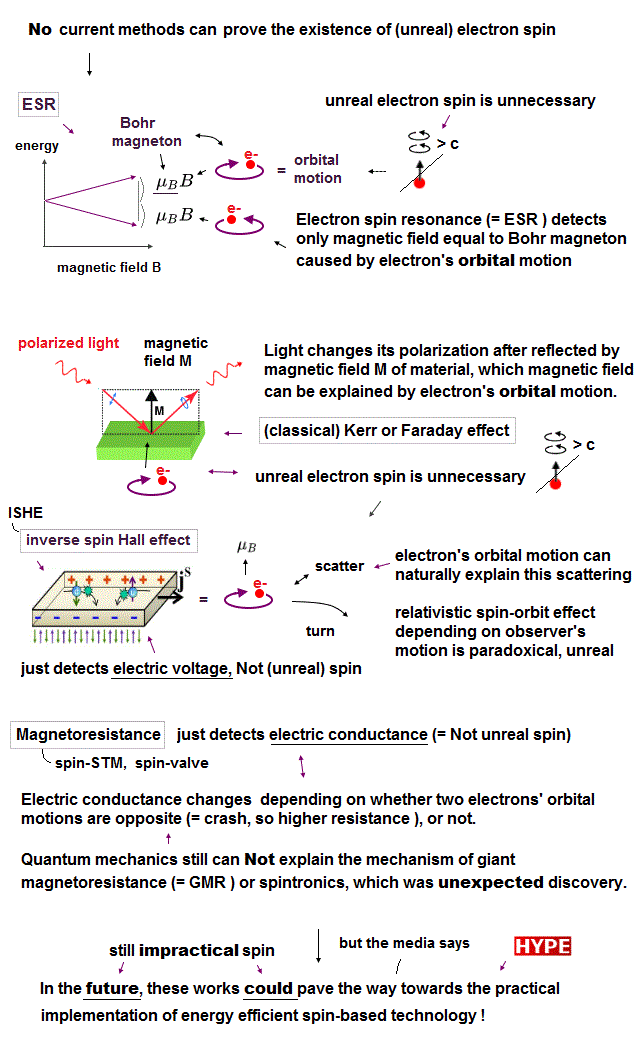
In fact, No experiments allegedly measuring electron spin can prove the existence of electron spin.
The electron spin is just an imaginary thing (= Physicists officially declare that an electron is Not actually spinning ).
Electron spin (magnetic) resonance (= ESR ) or electron paramagnetic resonance (= EPR ) is said to be the method of detecting electron spin (= though an electron is Not actually spinning ).
Of course, it is impossible to see the unrealistic electron spin (= if an electron is spinning, it must be the unrealistic faster-than-light spinning ! ) or its angular momentum (= or g-factor ) directly.
In ESR, all researchers can measure is energy level splitting (= through detecting light emitted from or absorbed into atoms ) under applied magnetic field B where the measured energy interval is equal to Bohr magneton (= μB ) × the magnetic field B × 2 (= difference between two orbits of upper and down magnetic directions ).
This ESR energy splitting can be naturally explained by the realistic electron's orbital motion whose magnetic moment is equal to Bohr magneton or the electron spin whose (spin) magnetic moment is also Bohr magneton ( this p.2, this 3rd-paragraph ).
Both the electron's orbit and electron spin are said to have the same Bohr magneton, accidentally, which are indistinguishable.
Because the magnetic moment is equal to g-factor × angular momentum.
Electron's orbital motion's magnetic moment = g-factor (= 1 ) × orbital angular momentum (= 1 ) × Bohr magneton = one Bohr magneton (= μB ).
Electron's spin magnetic moment is also spin-g-factor (= 2 ) × spin angular momentum (= 1/2 ) × Bohr magneton = one Bohr magneton (= μB, this p.3 ).
As a result, ESR can be naturally explained by the realistic electron's orbital motion, and the unrealistic electron spin is unnecessary (= the concept of Bohr magneton originally came from the successful Bohr's atomic orbit without spin ).
MRI (= magnetic resonance imaging ) or NMR (= nuclear magnetic resonance ) is caused by interaction between the applied external magnetic field and atomic nuclear magnetic moment (= nuclear spin is real, different from the unreal electron spin ) caused by classical nuclear spinning precession.
So MRI or NMR also does Not need the quantum mechanics (= quantum mechanics or QCD can Not predict nuclear spin ), contrary to hypes.
(Fig.M) Polarization of incident light is changed by material's magnetization (= by electron's orbit, Not electron spin ) in classical Kerr effect.
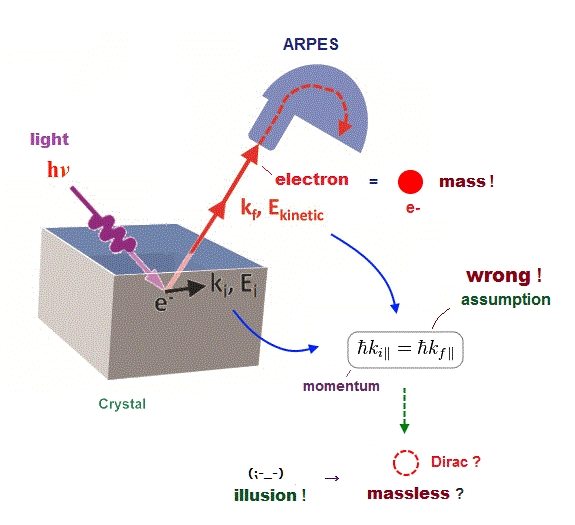
One of methods for allegedly detecting (fictional) electron's spin magnetic direction is magneto-optic Kerr effect (MOKE) where the polarization of the (classical) light wave reflected from (or penetrating ) the magnetic material changes depending on the material's magnetization, which material's magnetization has nothing to do with electron spin, though ( this p.13-1.1, this p.2-p.13 ).
Light or electromagnetic wave is known to change its polarization after being reflected by magnetic materials (= Not spin, this p.13(or p.7) ), depending on the direction of magnetic field (= magnetization or magnetic moment ). ← This magneto-optical Kerr effect (= MOKE ) or Faraday effect had been already known long before (unrealistic) quantum mechanics was born ( this p.20 ), so electron spin (or quantum photon particle ) is irrelevant to this light reflection.
In Faraday effect, the polarization of (classical) light wave getting through the material changes depending on the material's magnetization parallel or antiparallel to light propagation. ← the different directions of magnetization means the different directions of the electron's orbital motion that differently affects the right or left-circularly-polarized light.
These Kerr or Faraday effects can be naturally explained by classical electromagnetic wave theory and the realistic electron's orbital motion whose magnetic moment or Bohr magneton (= which modifies the light polarization ) is equal to that of (unreal) electron spin. ← Both the orbital motion and electron spin with the same Bohr magneton are indistinguishable with respect to magnetization.
Actually, in Kerr effect, only when the material's magnetic field includes the component parallel to the incident electromagnetic light wave's propagating direction (= polar or longitudinal ), this light's (magnetic) phase is modified, and resultantly the light's polarization is changed like linearly → elliptically-polarized light ( this p.3-5, this p.13-14(or p.7-8), this Figure 2 ).
↑ This Kerr effect just agrees with classical light wave theory = when the parallel component phase of electromagnetic wave changes, the light polarization (= linear ↔ circular ) is known to change.
The light polarization change by material's magnetization through this Kerr effect is too tiny to improve or replace today's data storage device (= so this Kerr MOKE effect is used only in impractical experiments )
This p.3-last-paragraph says "Since the MOKE AC signals are typically very weak, great care must be taken "
This p.40(or p.39)-last~p.41(p.40) says
"image with a very low Kerr signal and very dim (dark image). Kerr effect is already too small to be observed, this large amount of light loss will further reduce the Kerr
sensitivity of the setup"
↑ As a result, as long as this Kerr effect or MOKE (= whose signal is too weak, and which needs expensive bulky light-generating, detecting devices ) is used in (fictitious spintronics) experiments, it will never lead to developing today's technology.
(Fig.I) Electron's orbit (= Not electron spin ) is scattered by other atomic orbits, causing tiny voltage in inverse spin Hall effect.
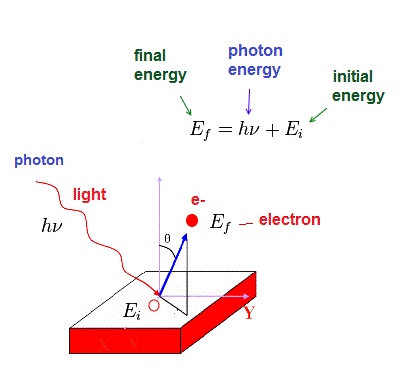
Another main method of allegedly detecting electron's spin magnetic direction is inverse spin Hall effect (= ISHE ), which has nothing to do with electron spin, contrary to that name.
In the inverse spin Hall effect (= equal to spin Hall effect ), the magnetic current (= caused by electron orbital motion or unreal spin ) is said to be changed into the measurable electric voltage change ( this p.2-Fig.1 ). ← The unreal electron spin itself is directly undetectable in this method.
↑ Electrons orbiting in different directions are scattered or veer in the different directions (= left or right side ) due to the different friction or collision with the surrounding electrons like classical Magnus effect ( this p.3-2nd-last-paragraph ). ← A rotating ball veers into left or right direction, depending on the the ball's rotating (= electron's orbiting ) direction that influences the friction against the surrounding air.
↑ So when electrons' current with magnetization in one direction is injected, they tend to be slightly scattered in one direction (= left or right side with respect to the moving direction ), which causes the measurable (faint) electric voltage, which is the true mechanism of the inverse (fake) spin Hall effect or ISHE without spin.
↑ A point-like spinning electron (= Not actual spinning though ) with almost zero size can Not cause this (electric) scattering (= depending on the spinning direction ) due to the friction against the surrounding electrons (= electrons cannot directly touch each other due to Coulomb repulsion ), so it has to rely on paradoxical relativistic spin-orbit magnetic interaction that contradicts the original Einstein relativity, so the electron spin is false.
(Fig.SA) Spin-ARPES just measures electrons scattered by magnetic materials, Not measures electron spin (= which can be replaced by electron's orbit )
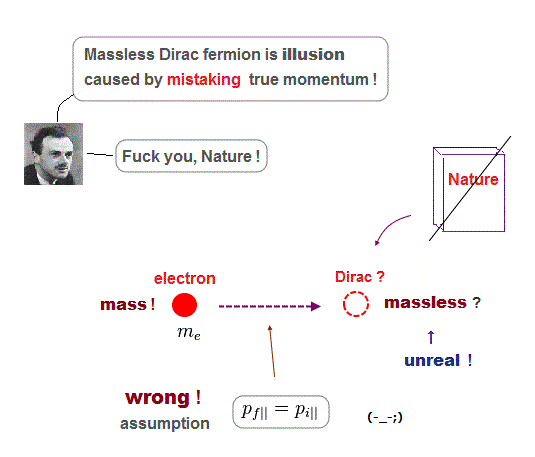
To roughly estimate (fictional) electron spin's direction, the current physicists often rely on very unreliable instruments called spin-ARPES (= angle resolved photoemission spectroscopy ) based on measuring the direction in which electrons (= generated by applying classical incident light ) are scattered.
The point is it is impossible to measure the direction of the (unrealistic) electron spin itself or spin magnetic direction directly in this spin ARPES or other experiments.
This spin-ARPES just roughly measures the direction in which electrons are scattered by some magnetic material (= with very low detection efficiency < 0.01, this-p.6, this-p.47-52 ) instead of measuring the fictional electron spin, which can be replaced by the real electron's orbital motion.
↑ The electron's orbital motion's direction (= Not the fictional electron's spin direction ) inside material naturally affects the electrons' scattering directions (in spin-ARPES ).
If we apply external magnetic field to the unseen electron spin, this spin direction randomly flips (= changes ) in the direction parallel or anti-parallel to the external magnetic field, so the measured spin magnetic direction is not equal to the original unmeasurable spin direction.
In the famous Stern-Gerlach experiment, which just measured the magnetic moment of silver atoms instead of directly measuring the electron spin (= No evidence of spin ), the original silver's atom's magnetic moment direction was changed randomly in direction parallel or antiparallel to the external magnetic field.
So they have to rely on other methods (irrelevant to electron spin) of just measuring electrons' scattering direction like in spin-ARPES instead of directly measuring electron spin magnetic moment's direction ( this spin detector at Bloch, this p.9 ).
This p.6-2. says
"Unfortunately, the concept of a simple Stern–Gerlach type
spin separator does Not work for charged particles like electrons."
So they try to (baselessly) 'guess' the (imaginary) electron's spin direction by vaguely seeing the directions or intensities of electrons scattered by some metals like Au target, which method is called spin-ARPES.
In this Spin-ARPES, they (baselessly) claim electrons ejected by incident light by photoelectric effect are sent to hit the metal, and get scattered by this metal toward right or left sides depending on the (unseen) electron's spin direction.
↑ So even this spin-ARPES cannot measure the direction of the electron spin itself or spin magnetic moment directly.
First of all, electrons easily change their original (fictitious) spin magnetic directions when they absorb the incident light's energy (= so they cannot know the material's original electron's spin state or direction by this spin-ARPES ), and they are also affected by the material's other electrons' magnetic fields.
And the directions in which electrons are scattered are very uncertain, unpredictable, and easily influenced by the irrelevant multiple Coulomb scattering with other electrons and nuclei (= of course, electrons' orbital directions instead of a point-like fictitious electron spin also influence this scattering ).
↑ Electrons orbiting in different directions (= instead of the unrealistic spin ) are ejected and flying in slightly-different directions which easily affects the scattering directions or intensities of spin-ARPES result. ← Electron spin is unnecessary, electron's orbital motion can explain different scattering directions in spin-ARPES.
This p.2-2nd, 4th paragraphs-p.3 say
"we cannot simply use the spin of the electrons as a tag and measure
independently the photoelectron spectra for spin-up and spin-down electrons..
In practice, one therefore exploits the spin-dependence in
a scattering experiment (= instead of directly measuring spin's magnetic direction )
"
"Does the spin-polarized spectrum (= of spin-ARPES ) reflect the true spin polarization of the
electronic states in the system under study ? Unfortunately, this is Not necessarily true
several different mechanisms inherent in the photoemission process are discussed that affect the spin polarization that is experimentally observed"
"All these effects can hamper the characterization of spin-resolved bands in the ground state. They are in most cases not well known (= many unknown factors make spin-ARPES results unreliable )."
A spinning electron (= Not real spinning though ) is a point-like particle with almost no size, so it is impossible for such a point-like electron spin to affect electrons' scattering direction, when electrons hit the metal (= ex. Au target ).
So physicists needed to fabricate some imaginary mechanism of spin-ARPES where the electron spin direction affecting (Coulomb) scattering is said to be based on relativistic spin-orbit effect (= called Mott scattering ) or fictitious exchange interaction (= VLEED scattering, this p.49-52 ) lacking real exchange force ( this-lower-our approach ).
Quantum mechanical artificial pseudo-model cannot predict this ad-hoc exchange energy or relativistic spin-orbit interaction due to artificially-chosen exchange-energy or pseudo-potential ( this p.10 ).
As shown in this, the relativistic spin-orbit effect is paradoxical and physically impossible, because they say moving electrons do Not experience (fictitious relativistic) magnetic field from the stationary nuclei, and only when seen from the electron's rest frame, the stationary nuclei appear to be moving and causing fictitious relativistic magnetic field that may affect spin-scattering direction through (fictitious) spin-orbit magnetic interaction.
↑ The fact that whether relativistic spin-orbit interaction may happen or not depends on observers' viewpoint (= seen from electron's rest frame or moving frame ) means this relativistic spin-orbit (fictitious) magnetic effect is paradoxical and wrong.
Furthermore, this spin-ARPES based on the fictitious spin-orbit effect (= Mott detector ) has very bad detection efficiency due to multiple uncertain scattering and accelerated electrons easily penetrating target metals without being detected ( this-middle-spin-resolved photoemission spectroscopy ).
This p.5-right-last-paragraph says -- Uncertain scattering
"However this effect is weak and cannot
be easily resolved at all scattering angles or energies..
At low energy the electron
cloud shields the nucleus reducing the Mott effect,
and for softer scattering angles the electron is likely
to multi-scatter (= this spin-ARPES cannot measure electron spin easily )"
Spin-ARPES based on (fictitious) quantum mechanical exchange energy (= called VLEED ) is said to distinguish the electron spin direction based on the ( unfounded ) assumption that electrons with different spin directions may be reflected by target magnetized metal with slightly-different probabilities ← the different electrons' scattering direction depends on electron spin direction through exchange interaction ?
But the detection efficiency of this spin-ARPES is also bad, and easily affected by many other irrelevant factors.
The detection efficiency of spin-ARPES is called Sherman function (= S ) which must be artificially and experimentally determined by fitting many free parameters, because different materials with different shapes and thickness, different incident lights, different angles easily change the measured electrons' scattering direction, and undermine the reliability of spin-ARPES or Sherman function ( this p.14-4. ).
The typical Sherman function or spin-ARPES detection efficiency is only about 0.2 ( this p.3-left ) which means spin-ARPES easily misinterprets the electron spin direction with 80% error rate.
This p.1-right says
"the estimation of Seff (= Sherman function ), however, is Not an easy task
The absolute calibration can be achieved by the usage of spin-polarized electrons,. but the setup of the spin-polarized electron source itself is hard work (= it is impossible to prepare electrons with some desired spin direction, because the applied magnetic field changes the electron spin direction randomly up or down ).
"
Even when this spin-ARPES was performed against the ferromagnets such as Fe, Co, Ni (= which should ideally show 100% spin polarization ), they often failed to show spin polarization ( this p.13-2nd-paragraph ).
Even in the latest research, the observed magnetic polarization asymmetry against ferromagnet nickel (= Ni ) is only less than 3.0% (= 97% electrons showed random scattering directions irrelevant to spin or magnetic directions, this-p.16-right-lower-green-line-asymmetry, this p.1-right obtained only 3.2% polarization asymmetry in magnetized ferromagnet Ni ).
This p.5-(2) showed Sherman function (= SFEL = non-error rate ) is only 0.1 (= 90% error rate ) and this p.6-Fig.2 says estimated polarization P is about 17% means the observed (fictitious spin) asymmetry is only 17% × 0.1 = 1.7% (= 98.3% of scattered electrons showed random scattering directions irrelevant to spin after absorbing incident light ).
↑ The directions of electrons' scattering are easily affected by positions, various conditions such as incident light and electron's orbital direction (= Not spin ), so this spin-ARPES based on uncertain electrons' scattering to roughly estimate (fictitious) electron's spin direction is very unreliable.
See Spin-torque-transfer (= STT )-MRAM is deadend, irrelevant to spin
See Spin wave or faint magnetic fluctuation is extremely short-lived and useless.
NV center in diamond is an useless quantum sensor
(Fig.Q) Spin qubit shows only complicated energy levels in each quantum dot irrelevant to electron spin.
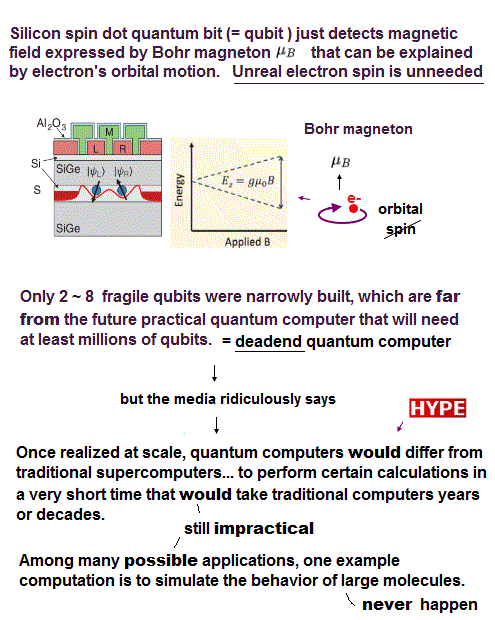
Spin qubit quantum computer tries to use the spin up or down direction of an electron confined in a quantum dot (= called an artificial atom = a small semiconductor consisting of many atoms) by adjustable electromagnetic field as a quantum bit or qubit (= electron spin up = 0, spin down = 1 ).
↑ But an electron is Not actually spinning, so electron spin does Not exist.
Physicists can detect Not the electron spin itself but two energy levels whose interval is 2gμBB (= g is g-factor, μB is Bohr magneton caused by electron's orbit, Not by electron spin, B is the applied external magnetic field ) interacting with microwave.
↑ If spin qubit really utilized the (fictional) electron spin, this g-factor must be "2".
But actually they can detect more complicated g-factor values completely different from electron spin's g-factor 2.
So there is No evidence of spin qubits using (fictional) electron spins.
The future practical quantum computer is said to require more than millions of qubits ( this 2nd-paragraph, this 3rd-paragraph, this 1st-paragraph, this p.3-1.introduction ).
But the current silicon spin qubits are only several ~ 6 qubits ( = each qubit can take only 0 or 1 values, so just 6 bitstring can Not compute anything. this p.1-left, Intel's latest hyped 12-qubit chip only for academic research with No practical use, is just about platform, and Not about building 12 qubits themselves ) which are far from practically-required millions of qubits.
Even the latest overhyped silicon-based quantum computer still has only impractical 6 qubits (= still Not a computer, No progress, this-2nd~3rd-paragraphs, this-3~4th-paragraphs, 5/17/2025 ), far from millions of qubits required for a practical quantum computer ( this-3~4th-paragraphs ).
The maximum number of nuclear spin qubits is just 9 (out of 11 qubits ).
In addition to these impractically small numbers of qubits, the current quantum computers (= still Not computers ) are too error-prone to be useful.
This p.5-Fig.5 shows preparing just 3-qubit GHZ state (= all 3 qubits are 000 or 111 bit states ) caused high error rate of 20~30% (= Fig.5g shows fidelity = 1 - error rate is 71.4 ~ 83.6% ), which is completely useless.
The gyromagnetic ratio or g-factor is the ratio of magnetic moment to angular momentum. Classical electron's orbit's g-factor is 1, and the (fictional) electron spin's g-factor is said to be 2.
↑ This spin-g-factor itself is unmeasurable, and only the magnetic moment called Bohr magneton is measurable, which is the same as the classical electron's orbit, because the spin-angular momentum 1/2 (= 1/2ℏ ) is half of the orbital quantized angular momentum of 1 (= ℏ ).
Quantum dot-spin qubit uses the complicated (effective) magnetic moment or g-factor (= different from spin-g-factor 2 ) combining multiple electrons' orbital motion instead of the fictional spin, so the spin-qubit does Not use electron spin.
This p.2-right-4th-paragraph-ESR spectroscopy in quantum dot spin qubit used g-factor = 0.35, which is different from electron spin g-factor of 2.
This site ↓
p.59-6.1-Qubit uses g-factor = -0.44 (= Not spin g-factor of 2).
p.62-top says "effective (= fake ) g-factor geff, which can be larger than the bare (spin) g-factor."
This-p.3-Fig.2h used g-factor = 11.255.
This p.3-last used g factor = 9.28.
This p.1-right-lower used g-factor = -0.4.
↑ None of these g-factors is the electron spin g-factor = 2
So there is No evidence of electron spin in quantum dot that can artificially control fake (= effective ) g-factor by applied voltage.
Silicon-type spin qubit is said to use the quantum dot's (unrealistic) electron spin up (= 0 ) or down (= 1 ) as each qubit's state.
But it is impossible to observe an unrealistic electron spinning directly.
And their so-called spin-qubit does Not use electron spin, because they used artificial g-factors different from the spin-g-factor of 2.
All they can measure is irrelevant electric current or Coulomb voltage ( this Fig.1c ) instead of electron's spin magnet.
They baselessly claim, when two adjacent quantum dots include two electrons with the same spin up-up or down-down, these two electrons may repel each other by quantum mechanical (fictitious) Pauli principle exchange energy lacking real exchange force, and eventually electric current may be blocked under applied voltage. ← just imagination
First of all, a quantum dot is an artificial (= Not real ) atom with about 50nm size ( this p.2-Fig.1 ) containing more than 1000 ~ 10000 of atoms that is far bigger than a single atom (= only 0.1 nm ), hence, each quantum dot has large space enough to contain more than two electrons without caring about whether two electrons enter one same smaller atomic orbital exerting Pauli exclusion principle or not.
Actually, in this quantum dot's Pauli blockade mechanism, one electron was artificially fixed by external electric field in the place completely distant from the other electron, and only this other electron could move as electric current through different routes ( this p.3-Fig.1 ), which had nothing to do with Pauli principle repulsion that requires two electrons to enter the same one tiny atomic orbital far smaller than a single quantum dot (= consisting of 10000 atoms ) or a bigger artificial atom.
In the actual quantum dot or artificial atom, much more complicated mechanism happens, and the electric current depends on relationship between electron's orbital motion and other surrounding atoms, which can be artificially-controlled by external (exchange) voltage ( this p.1-right-2nd-paragraph ). ← Fictional electron spin is completely irrelevant to spin qubit.
(Fig.M) Million silicon spin qubits are overhyped fake news.
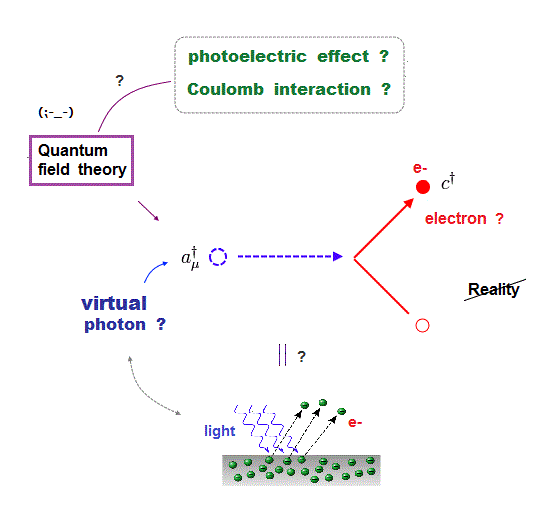
Insider Brief of this overhyped news (9/15/2025) says
"The system integrates a silicon spin-qubit QPU"
"Quantum Motion aims to (= still unrealized ) scale its tile-based architecture to millions of qubits (= impossible ), advancing fault-tolerant, commercially viable quantum computing." ← fake news
↑ The present largest silicon-electron-spin qubit quantum computer has only 6 qubits (= one qubit can take only 0 or 1 value = No progress ), which can never be scaled up to millions of qubits , contrary to the above overhyped fake news.
This latest research (5/25/2025)-p.1-left-3rd-paragraph says
"Finally, in a six qubit device, initialization, single- and two-qubit gates,
and readout were simultaneously tuned up across the full
system, although entangling circuits were implemented
with up to three qubits only (= actually only 3 qubits or 3 bitstring so far )"
↑ Despite extremely long years of researches and hypes, only 6 useless silicon spin qubits have barely been built.
So millions of qubits required for a practical quantum computer can never be realized.
The recent overhyped silicon-based quantum chips also used only 2 impractical qubits (= Q1, Q2, this-p.17-p.20 ), far from millions of qubits.
(Fig.F) A single electron 'breaks' into two fictional quasiparticles of spinon carrying only spin and holon carrying only charge !? ← this ridiculous impractical quasiparticle model stops science from advancing
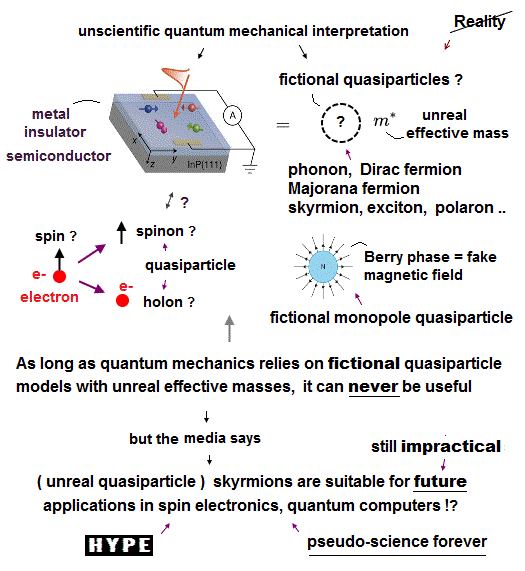
Quantum mechanical Schrödinger equations for multi-electron atoms are unsolvable (= unable to predict atomic energies ), useless and too time-consuming for larger molecules and materials.
So quantum mechanics needs fictitious unreal quasipartice model with fake effective mass and charge ( this 3rd-paragraph ) to approximately explain the multi-particle material's electromagnetic properties such as electric conductance.
These unscientific quantum mechanical quasiparticle models lack real atomic shapes (= these old impractical quasiparticle models have made No progress for about 100 years ), so they clearly prevent the development of science and technology.
This 1st paragraph says
"where the collective behavior of a large number of interacting particles can be described as if they were single particles. These quasiparticles are Not elementary particles"
↑ So these fictional quasiparticle models with fake effective masses (= the current mainstream physical models ) just approximately (and incorrectly) represent the collective behavior of the actual many-atomic material as one pseudo-particles with No real shapes ( this p.2-left, this p.1-left ) due to the impractical multi-electron Schrödinger equations ( this 3rd-paragraph ).
This p.2-2nd~3rd paragraphs and p.4-3rd~4th-paragraphs say
"Very often, the Schrodinger equation
does not directly provide such an understanding (= quantum mechanical Schrödinger equation is useless )."
"As we cannot generally directly use the Schrodinger equation to understand an interacting system, we have to start from the beginning when we are faced with a many-body system. We have to treat the many-body system as a black box, just as we treat our mysterious and unknown universe (= quantum mechanics is unable to deal with many-atomic materials )."
"But, in the many-body system, the collective excitations are not elementary... Thus, in many-body systems we have collective excitations (also called quasiparticles ) "
"..If we believe that our vacuum can be viewed as a special many-body material, then we have to conclude that there are no elementary particles (= quasiparticles are Not real elementary particles )."
↑ To hide this inconvenient truth of the present deadend science based on unrealistic quantum mechanical quasiparticle models (= based on wrong ARPES measurement ) lacking physical shapes (= expressed just as meaningless math operators, this p.13-last-paragraph, this p.22 ), the media and academia need to spread overhyped news with misleadingly colorful particle picture (= fictitious quasiparticles can move faster than light !? this p.11-2nd-paragraph ) that appears to be real.
See this page.
See this page.
See this page.
See this page.
See this page.
See this page.
See this page.
See this page.
See Spin Hall effect is useless.

Feel free to link to this site.